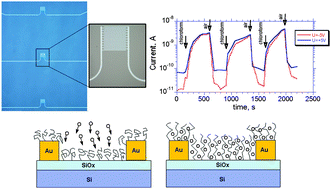Electrical conductivity of insulating polymer nanoscale layers: environmental effects†
Abstract
As electronic devices are scaled down to submicron sizes, it has become critical to obtain uniform and robust insulating nanoscale polymer films. For that reason, we address the electrical properties of grafted polymer layers made of poly(glycidyl methacrylate), polyacrylic acid, poly(2-vinylpyridine), and polystyrene with thicknesses of 10–20 nm. It was found that layers insulating under normal ambient conditions can display a significant increase in conductivity as the environment changes. Namely, we demonstrated that the in-plane electrical conductivity of the polymer grafted layers can be changed by at least two orders of magnitude upon exposure to water or organic solvent vapors. Conductive properties of all polymer grafted films under study could also be significantly enhanced with an increase in temperature. The observed phenomenon makes possible the chemical design of polymer nanoscale layers with reduced or enhanced sensitivity to the anticipated change in environmental conditions. Finally, we demonstrated that the observed effects could be used in a micron-sized conductometric transducing scheme for the detection of volatile organic solvents.


 Please wait while we load your content...
Please wait while we load your content...